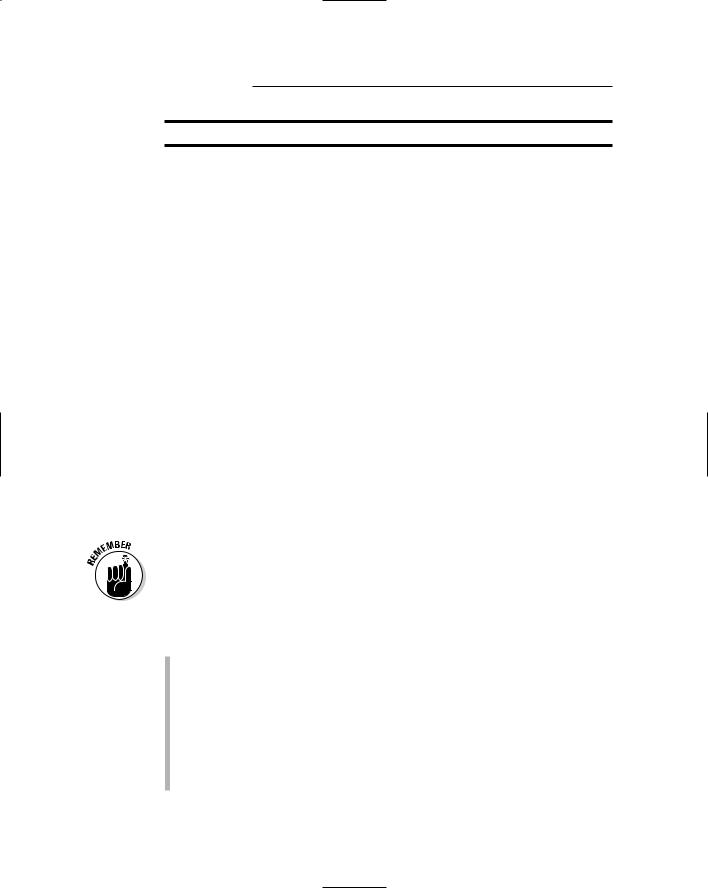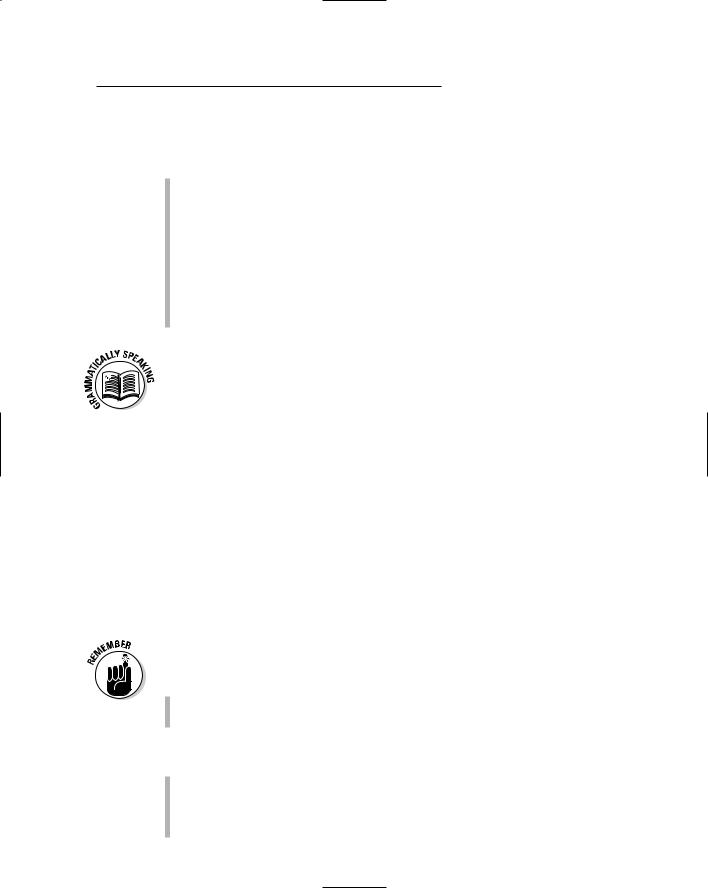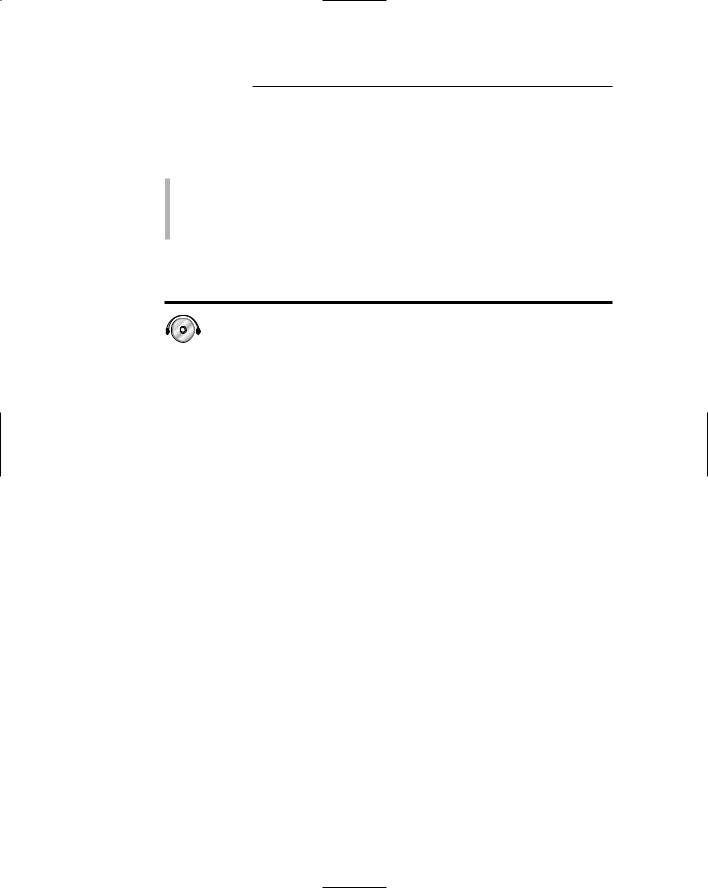
Arabic_for_Dummies
.pdf
106 Part II: Arabic in Action
Notice that the singular demonstratives (haadhaa, haadhihi, dhaalika, and tilka) are all gender-defined, meaning that you use a specific demonstrative corresponding to whether the object being referred to is masculine or feminine. On the other hand, the plural demonstratives, haa’ulaa’ii and ‘ulaa’ika, are gender-neutral, meaning that the gender of the object being pointed to doesn’t matter.
In a sentence, you always place the demonstrative word before the object being pointed to, which is often a noun. In addition, the noun must be defined using the definite prefix pronoun al-. Here are some examples to illustrate the use of the definite prefix pronoun:
haadhaa al-walad (hah-zah al-wah-lad; this boy)
haadhihi al-bint (hah-zee-hee al-bee-net; this girl)
dhaalika ar-rajul (zah-lee-kah ah-rah-jool; that man)
tilka al-mar’a (teel-kah al-mar-ah; that woman)
haa’ulaa’ii al-banaat (hah-oo-lah-ee al-bah-nat; these girls)
‘ulaa’ika an-nisaa’ (oo-lah-ee-kah ah-nee-sah; those women)
It’s important to not only follow the specific order of the demonstrative phrase (demonstrative word followed by the noun) but also to make sure the noun is defined. If the noun isn’t defined with the definite article prefix al-, the meaning of the demonstrative phrase changes dramatically. Arabic has no verb “to be” in the present tense, but because every language requires “is/are” sentences to function appropriately, “is/are” sentences are created in Arabic by manipulating these little definite articles. If you include a demonstrative followed by an undefined noun, you create a demonstrative “is/are” sentence. Using the examples from the earlier list, look at what happens to the demonstrative phrase when the definite article isn’t included:
haadhaa walad (hah-zah wah-lad; this is a boy)
haadhihi bint (hah-zee-hee bee-net; this is a girl)
dhaalika rajul (zah-lee-kah rah-jool; that is a man)
tilka mar’a (teel-kah mar-ah; that is a woman)
haa’ulaa’ii banaat (hah-oo-lah-ee bah-nat; these are girls)
‘ulaa’ika nisaa’ (oo-lah-ee-kah nee-sah; those are women)
As you can see by comparing these two lists, one small prefix can radically alter the meaning of a sentence.

Chapter 6: Going Shopping 107
Talkin’ the Talk
Omar is looking to buy a black leather jacket, so he asks the salesperson for this particular item.
Omar: hal ‘indakum jakiiTaat?
hal een-dah-koom jah-kee-tat?
Do you have jackets?
Salesperson: na’am. ‘indanaa ‘anwaa’ kathiira min aj-jakiiTaat. ‘an
‘ay naw’ tabHathu?
nah-am. een-dah-nah an-wah kah-thee-rah meen ah- jah-kee-tat. an ay nah-weh tab-hah-thoo?
Yes. We have many different kinds of jackets. Which kind are you looking for?
Omar: ‘uriidu jakiiTa bi aj-jald.
oo-ree-doo jah-kee-tah bee ah-jah-led.
I want a leather jacket.
Salesperson: Tayyib. ‘itba’nii min faDlik.
tah-yeeb. eet-bah-nee meen fad-leek.
Okay. Follow me please.
Omar follows the salesperson to the jacket section.
Salesperson: ‘ulaa’ika kul aj-jakiiTaat ‘indanaa. oo-lah-ee-kah kool ah-jah-kee-tat een-dah-nah.
Those are all the jackets we have.
Omar: ‘uHibbu haa’ulaa’ii aj-jakiiTaat. oo-hee-boo hah-oo-lah-ee ah-jah-kee-tat.
I like these jackets.
Salesperson: ‘anaa muwaafiq. ‘innahaa jamiila jiddan. ah-nah moo-wah-feek. ee-nah-hah jah-mee-lah jee-dan.
I agree. They are very beautiful.
Omar: ‘uriidu ‘an ‘ujarrib haadhihi. oo-ree-doo an oo-jah-reeb hah-zee-hee.
I would like to try on this one.

108 Part II: Arabic in Action
Salesperson: fawran. hal turiidu lawn khaaS? faw-ran. hal too-ree-doo lah-wen kass?
Right away. Are you looking for any particular color?
Omar: ‘uriidu dhaalika al-lawn. oo-ree-doo zah-lee-kah ah-lah-wen.
I want that color.
Words to Know
jakiiTa |
jah-kee-tah |
jacket |
naw’ |
nah-weh |
type/kind |
jald |
jah-led |
leather |
yatba’u |
yat-bah-oo |
following |
‘itba’ |
eet-bah |
follow |
|
|
(imperative) |
‘itba’nii |
eet-bah-nee |
follow me |
muwaafiq |
moo-wah-feek |
agree |
jamiil |
jah-meel |
beautiful (M) |
jamiila |
jah-mee-lah |
beautiful (F) |
‘ujarrib |
oo-jah-reeb |
to try (I/me) |
lawn |
lah-wen |
color |
khaaS |
kass |
particular (M) |
khaaSSa |
kah-sah |
particular (F) |
fawran |
faw-ran |
right away |

Chapter 6: Going Shopping 109
Comparing Merchandise
Have you ever been shopping and found yourself debating between two or more comparable items? Perhaps you have a general idea of what you want to buy — a television, for instance — but you aren’t sure what year, make, or model you want. In these instances, being able to compare merchandise is important. In this section, you discover how to evaluate comparable (and incomparable) items based on a variety of important criteria, such as price, quality, and durability.
In order to be able to compare different items, it’s necessary to have an understanding of degrees of adjectives and superlatives. In English, degrees of adjectives have straightforward applicability. For example, in order to say that something is bigger than another thing, you simply add the suffix -er to the adjective; hence “big” becomes “bigger.” Furthermore, when you’re comparing two or more items, you use comparatives, meaning you use both the degree of adjectives followed by the preposition “than.” For instance, “the truck is bigger than the car.” To say that something is the biggest, you only need to add the suffix -est to the adjective; so “big” becomes “biggest,” as in “it’s the biggest car.” This form is called a superlative.
Fortunately, the structures of degrees of adjectives, comparatives, and superlatives in Arabic are fairly similar to those in English.
Comparing two or more items
Adjectives are the linguistic backbone that allow for comparisons between different items, products, or goods. Table 6-2 lists some of the most common adjectives followed by their comparative forms.
Table 6-2 Arabic Adjectives and Their Comparative Forms
Adjective |
Pronunciation |
Translation |
Comparative |
Pronunciation |
Translation |
kabiir |
kah-beer |
big |
‘akbar |
ak-bar |
bigger |
|
|
|
|
|
|
Saghiir |
sah-geer |
small |
‘aSghar |
ass-gar |
smaller |
|
|
|
|
|
|
Hasan |
hah-san |
good |
‘aHsan |
ah-san |
better |
|
|
|
|
|
|
suu’ |
sooh |
bad |
‘aswa’ |
as-wah |
worse |
|
|
|
|
|
|
rakhiiS |
rah-kees |
cheap |
‘arkhas |
ar-kas |
cheaper |
|
|
|
|
|
|
ghalii |
gah-lee |
expensive |
‘aghlaa |
ag-lah |
more |
|
|
|
|
|
expensive |
|
|
|
|
|
|
(continued)

110 Part II: Arabic in Action
Table 6-2 (continued)
Adjective |
Pronunciation |
Translation |
Comparative |
Pronunciation |
Translation |
sarii’ |
sah-reeh |
fast |
‘asra’ |
ass-rah |
faster |
|
|
|
|
|
|
baTii’ |
bah-teeh |
slow |
‘abTa |
ab-tah |
slower |
|
|
|
|
|
|
thaqiil |
tah-keel |
heavy |
‘athqal |
at-kal |
heavier |
|
|
|
|
|
|
khafiif |
kah-feef |
light |
‘akhfaa |
ak-fah |
lighter |
|
|
|
|
|
|
jamiil |
jah-meel |
pretty |
‘ajmal |
aj-mal |
prettier |
|
|
|
|
|
|
bashii’ |
bah-sheeh |
ugly |
‘absha’ |
ab-shah |
uglier |
|
|
|
|
|
|
ba’iid |
bah-eed |
far |
‘ab’ad |
ab-ad |
farther |
|
|
|
|
|
|
qariib |
kah-reeb |
near |
‘aqrab |
ak-rab |
nearer |
|
|
|
|
|
|
jadiid |
jah-deed |
new |
‘ajadd |
ah-jad |
newer |
|
|
|
|
|
|
qadiim |
kah-deem |
old |
‘aqdam |
ak-dam |
older |
|
|
|
|
|
|
Place these adjectives in their appropriate context in the phrase or sentence — using these adjectives independently changes their meanings. Similar to the English language structure, the comparative form of adjectives always follows this pattern:
noun + adjective comparative form + preposition min (meen; than) + second adjective
It’s essential that you include the preposition min right after every comparative adjective. In addition, all nouns being compared need to be defined by attaching to them the definite article prefix al-.
Here are some common examples of comparative sentences using the adjective forms:
al-bint ‘akbar min al-walad. (al-bee-net ak-bar meen al-wah-lad; The girl is bigger than the boy.)
at-tilifizyuun ‘aghlaa min al-midyaa’. (ah-tee-lee-fee-zee-yoon ag-lah meen al-meed-yah; The television is more expensive than the radio.)
as-sayyaara ‘asra’ min as-shaaHina. (ah-sah-yah-rah as-rah meen ah-shah- hee-nah; The car is faster than the bus.)
aj-jakiiTa ‘arkhas min al-qamiis. (ah-jah-kee-tah ar-kas meen al-kah-mees;
The jacket is cheaper than the shirt.)

Chapter 6: Going Shopping 111
When forming these types of sentences, you may add demonstratives to be even more specific. Here are examples of comparative sentences used in conjunction with demonstratives:
haadhihi al-bint ‘akbar min dhaalika al-walad. (hah-zee-hee al-bee-net ak-bar meen zah-lee-kah al-wah-lad; This girl is bigger than that boy.)
haa’ulaa’ii as-sayyaaraat ‘asra’ min ‘ulaa’ika as-shaahinaat. (hah-oo-lah- ee ah-sah-yah-rat as-rah meen oo-lah-ee-kah ah-shah-hee-nat; These cars are faster than those buses.)
tilka al-‘imra’a ‘ajmal min dhaalika ar-rajul. (teel-kah al-eem-rah-ah ajmal meen zah-lee-kah ah-rah-jool; That woman is prettier than that man.)
haadhaa al-walad ‘akbar min ‘ulaa’ika al-banaat. (hah-zah al-wah-lad ak-bar meen oo-lah-ee-kah al-bah-nat; This boy is bigger than those girls.)
Notice in the examples that the adjective comparative form remains constant whether the nouns being compared are a combination of singular/singular, singular/plural, or plural/plural. In other words, the adjective comparatives are gender-neutral: They remain the same regardless of both gender and number.
Picking out the best item
A superlative describes something that is of the highest order, degree, or quality. Some common superlatives in English are “best,” “brightest,” “fastest,” “cleanest,” “cheapest,” and so on. Superlatives in Arabic are actually very straightforward and shouldn’t be hard for you to understand if you have a good grasp of comparatives (see the preceding section).
Basically, a superlative in Arabic is nothing more than the comparative form of the adjective! The only difference is that comparatives include the preposition min (than) and superlatives don’t include any preposition. For example, to tell someone, “This is the biggest house,” you say haadhaa ‘akbar manzil
(hah-zah ak-bar man-zeel).
The biggest differences between superlatives and comparatives are:
The superlative adjective always comes before the noun.
When expressing a superlative, the noun is always undefined.
Here are some common examples of superlative sentences:
haadhihi ‘ajmal bint. (hah-zee-hee aj-mal bee-net; This is the prettiest girl.)
dhaalika ‘ab’ad dukkaan. (zah-lee-kah ab-ad doo-kan; That is the farthest store.)

112 Part II: Arabic in Action
If you switch the order of the words to demonstrative + noun + superlative, be sure to define the noun. That’s the only other way you can construct a superlative sentence. For example:
haadhihi al-bint ‘ajmal. (hah-zee-hee al-bee-net aj-mal; This girl is the prettiest.)
dhaalika ad-dukaan ‘ab’ad. (zah-lee-kah ah-doo-kan ab-ad; That store is the farthest.)
Talkin’ the Talk
Adam stops by an electronics store to buy a camera. The salesman helps him pick the best one.
Salesman: SabaaH an-nuur wa marHaba ‘ilaa ad-dukkaan al-iliktroniyaat.
Sah-bah ah-noor wah mar-hah-bah ee-lah ah-doo-kan al-ee-leek-troo-nee-yat.
Good morning and welcome to the electronics store.
Adam: shukran. ‘anaa ‘abHathu ‘an muSawwira. shook-ran. ah-nah ab-hah-thoo an moo-sah-wee-rah.
Thank you. I am looking for a camera.
Salesman: hal tabHathu ‘an naw’ mu’ayyin?
hal tab-hah-thoo an nah-weh moo-ah-yeen?
Are you looking for a particular model?
Adam: ‘abHath ‘an ‘aHsan muSawwira. ab-hath an ah-san moo-sah-wee-rah.
I’m looking for the best camera.
Salesman: Tayyib. ‘indanaa haadhaa an-naw’ bi alwaan mutaghayyira.
Tah-yeeb. een-dah-nah hah-zah ah-nah-weh bee al-wan moo-tah-gah-yee-rah.
Okay. We have this model with different colors.
Adam: hal ‘indakum naw’ ‘aakhar?
hal een-dah-koom nah-weh ah-kar?
Do you have another model?

Chapter 6: Going Shopping 113
Salesman: na’am. haadhaa an-naw’ ath-thaanii mashhuur ma’a az-zabaa’in.
nah-am. hah-zah ah-nah-weh ah-thah-nee mash-hoor mah-ah ah-zah-bah-een.
Yes. This second model is popular with customers.
Adam: ‘ay naw’ ‘aHsan? ay nah-weh ah-san?
Which is the best model?
Salesman: an-naw’ ath-thaanii ‘aHsan min an-naw’ al-awwal. ah-nah-weh ah-thah-nee ah-san meen ah-nah-weh al-ah-wal.
The second model is better than the first model.
Adam: ‘uriidu ‘an ‘ashtarii an-naw’ ath-thaanii min faDlik. oo-ree-doo an ash-tah-ree ah-nah-weh ah-thah-nee meen fad-leek.
I’d like to buy the second model please.
Salesman: ‘ikhtiyaar mumtaaz! eek-tee-yar moom-taz!
Excellent selection!
Words to Know
muSawwira |
moo-sah-wee-rah |
camera |
muSawwir |
moo-sah-weer |
photographer |
mu’ayyin |
moo-ah-yeen |
particular (M) |
mu’ayyina |
moo-ah-yee-nah |
particular (F) |
mutaghayyir |
moo-tah-gah-yeer |
different (M) |
mutaghayyira |
moo-tah-gah-yee-rah |
different (F) |
zabaa’in |
zah-bah-een |
customers |
‘ikhtiyaar |
eek-tee-yar |
selection (M) |
‘ikthiyaara |
eek-tee-yah-rah |
selection (F) |

114 Part II: Arabic in Action
More Than a Few Words About
Buying and Selling
Perhaps the two most important verbs relating to shopping are yashtarii (yash-tah-ree; to buy) and yabii’u (yah-bee-ooh; to sell). Unlike other verbs in Arabic, these two critical verbs are irregular, which means they don’t follow a particular pattern. Because these verbs are widely used and have their own pattern, you should be familiar with how to conjugate them.
Use the form baa’a (bah-ah; sold) to conjugate yabii’u in the maaDii (past):
Form |
Pronunciation |
Translation |
‘anaa bi’tu |
ah-nah beeh-too |
I sold |
‘anta bi’ta |
ahn-tah beeh-tah |
You sold (MS) |
‘anti bi’tii |
ahn-tee beeh-tee |
You sold (FS) |
huwa baa’a |
hoo-wah bah-hah |
He sold |
hiya baa’at |
hee-yah bah-at |
She sold |
naHnu bi’naa |
nah-noo beeh-nah |
We sold |
‘antum bi’tum |
ahn-toom beeh-toom |
You sold (MP) |
‘antunna bi’tunna |
ahn-too-nah beeh-too-nah |
You sold (FP) |
hum baa’uu |
hoom bah-ooh |
They sold (MP) |
hunna bi’na |
hoo-nah beeh-nah |
They sold (FP) |
antumaa bi’tumaa |
ahn-too-mah beeh-too-mah |
You sold (dual/MP/FP) |
humaa baa’aa |
hoo-mah bah-ah |
They sold (dual/MP) |
humaa baa’ataa |
hoo-mah bah-ah-tah |
They sold (dual/FP) |
The form yabii’u (yah-bee-oo; selling) is used to conjugate yabii’u in the muDaari’ (present):
Form |
Pronunciation |
Translation |
‘anaa ‘abii’u |
ah-nah ah-bee-oo |
I am selling |
‘anta tabii’u |
ahn-tah tah-bee-oo |
You are selling (MS) |
‘anti tabii’iina |
ahn-tee tah-bee-ee-nah |
You are selling (FS) |
huwa yabii’u |
hoo-wah yah-bee-oo |
He is selling |
hiya tabii’u |
hee-yah tah-bee-oo |
She is selling |

Chapter 6: Going Shopping 115
Form |
Pronunciation |
Translation |
naHnu nabii’u |
nah-noo nah-bee-oo |
We are selling |
‘antum tabii’uuna |
ahn-toom tah-bee-oo-nah |
You are selling (MP) |
‘antunna tabi’na |
ahn-too-nah tah-beeh-nah |
You are selling (FP) |
hum yabii’uuna |
hoom yah-bee-oo-nah |
They are selling (MP) |
hunna yabi’na |
hoo-nah yah-beeh-nah |
They are selling (FP) |
antumaa tabii’aani |
ahn-too-mah tah-bee-ah-nee |
You are selling (dual/ |
|
|
MP/FP) |
humaa yabii’aani |
hoo-mah yah-bee-ah-nee |
They are selling (dual/ |
|
|
MP) |
humaa tabii’aani |
hoo-mah tah-bee-ah-nee |
They are selling (dual/ |
|
|
FP) |
The verb form for “bought” in the maaDii is ‘ishtaraa (eesh-tah-rah; bought). Like baa’a, ‘ishtaraa is an irregular verb:
Form |
Pronunciation |
Translation |
‘anaa ‘ishtaraytu |
ah-nah eesh-tah-ray-too |
I bought |
‘anta ‘ishtarayta |
ahn-tah eesh-tah-ray-tah |
You bought (MS) |
‘anti ‘ishtarayti |
ahn-tee eesh-tah-ray-tee |
You bought (FS) |
huwa ‘ishtaraa |
hoo-wah eesh-tah-rah |
He bought |
hiya ‘ishtarat |
hee-yah eesh-tah-rat |
She bought |
naHnu ‘ishtaraynaa |
nah-noo eesh-tah-ray-nah |
We bought |
‘antum ‘ishtaraytum |
ahn-toom eesh-tah-ray-toom |
You bought (MP) |
‘antunna |
ahn-too-nah eesh-tah-ray- |
You bought (FP) |
‘ishtaraytunna |
too-nah |
|
hum ‘ishtaraw |
hoom eesh-tah-raw |
They bought (MP) |
hunna ‘ishtarayna |
hoo-nah eesh-tah-ray-nah |
They bought (FP) |
antumaa |
ahn-too-mah |
You bought (dual/ |
‘ishtaraytumaa |
eesh-tah-ray-too-mah |
MP/FP) |
humaa ‘ishtarayaa |
hoo-mah eesh-tah-rah-yah |
They bought (dual/MP) |
humaa ‘ishtarayataa |
hoo-mah eesh-tah- |
They bought (dual/FP) |
|
rah-yah-tah |
|
